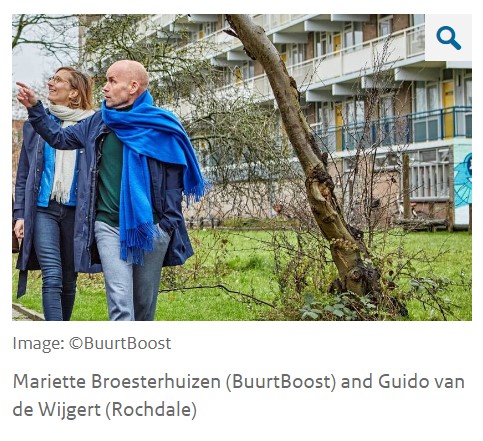Introduction to how the Netherlands are going about to fix a housing shortage issue. Topping involves adding another floor or layer to an already existing building in the Netherlands for housing purposes. According to government officials, the results of such an effort is great: at least 100,000 homes can be realized with topping up.
Topping is also popular in the Netherlands according to the government. More and more municipalities, housing corporations and commercial parties are building extra homes on flat roofs. But topping up offers more opportunities than just adding homes.
For Neighborhood Developer BuurtBoost, a collaboration between VORM and Did Real Estate Development, topping up is one of the means to boost post-war neighborhoods and add housing. They do this on behalf of housing corporations SOR, Woonbron and Rochdale, among others.
Many post-war neighborhoods in the Netherlands face the same challenges. The homes are in need of sustainability, there is a need for extra facilities and the quality of life is under pressure. In addition, the growing housing shortage requires more housing in the city centers. Mariette Broesterhuizen, neighborhood developer at BuurtBoost:
“At BuurtBoost, we therefore take an integrated approach to improving neighborhoods. We are looking at what the challenges are in the neighborhood and how we can also give the existing neighborhood a boost by adding extra homes. Adding extra housing offers opportunities to improve the quality of life, public space and facilities in a neighborhood.”
What is Topping? Topping is the addition of homes by raising an existing building by one or more floors. Research shows that topping up could create approximately 100,000 extra homes by 2030. This makes it a good way to make better use of existing buildings and to contribute to the housing challenge.
Integral approach
Housing corporation Rochdale called in BuurtBoost to improve the Klipperbuurt in the Banne Noord district of Amsterdam. Guido van de Wijgert, area and sustainability developer at Rochdale: “We want to make our homes in the Klipperbuurt more sustainable and connect them to the heat network. But there are also areas for improvement in terms of quality of life and safety. Then we thought: why don’t we tackle that at the same time?” BuurtBoost’s BuurtScan shows that making the homes in the Klipperbuurt more sustainable can be combined with the creation of homes by expanding at the bottom of buildings or by topping up. Guido:
“BuurtBoost investigated how many homes we could add without having to demolish a lot. Topping up came out as one of the possibilities.”
Involving residents
After BuurtBoost mapped out the opportunities, points of attention and spatial potential with the BuurtScan, participation in the Klipperbuurt started. Mariette: “Involving residents is important to arrive at a good approach. People have often lived in the area for a long time and therefore have a lot of knowledge. It is therefore important to hear from the residents themselves how they experience their neighbourhood and home. This gives us a better understanding of what is going on in a neighbourhood. This is not only about housing, but also about its affordability or a healthy living environment. These are all things we want to improve.” Bas Bulten, neighborhood developer at BuurtBoost, explains: “Improving the affordability of housing goes hand in hand with making it more sustainable. By making it more sustainable, fixed costs are reduced and residents are cheaper. Improving health can be done, for example, by reducing nuisance or by constructing new walking routes so that people exercise more.”
Guido does acknowledge that it is difficult to involve residents in an integrated approach. “Residents only want one thing and that is renovation and sustainability in the short term. That’s what we promised them. As soon as we tell them that we are going to tackle the neighbourhood, the first question we get is: ‘But when will it be my house’s turn?’” He explains that residents in the Klipperbuurt suffer from draughts, damp and mould. “These are acute problems, which we want to eliminate as soon as possible.” Guido notices that residents are mainly looking for clarity.
“In the past, commitments have been made that we have not been able to keep. It is therefore now extra important that we listen carefully to them and explain why we want to take an integrated approach to the neighborhood, for example to create extra housing or play space for their children.”
More diversity
In addition to creating extra living space, the topping should contribute to more diversity in the Klipperbuurt. Guido:
“At the moment, the supply consists of 100% social housing. They are also quite large houses of four rooms, which we would like to preserve.”
To create variation in the offer, the new top homes will mainly be two-room apartments and studios. Guido:
“In this way, we try to bind other and younger target groups to the neighborhood.”
In addition, a diverse housing supply offers opportunities for residents to move on to another home in the neighborhood, for example when they need less living space. A number of the top-up homes will be social rent, but homes in the free sector and mid-market rental will also be added.
Additional Facilities
In any case, more people in the neighborhood means greater support for facilities. Mariette:
“Traditionally, there were many local facilities in neighborhoods such as the Klipperbuurt, such as a supermarket, greengrocer or neighborhood café. But because the number of people per household has almost halved over the past 50 years, many facilities have disappeared.”
The idea of the parties involved is to add shops on the ground floor of the buildings and to create workplaces and studios for self-employed people in current garage boxes. In other words, social facilities and small-scale business, because a neighborhood point and community room are already there. Guido:
“In addition, we asked residents what facilities they miss in the neighborhood. This showed that people would like meeting places for the elderly, such as vegetable gardens.”
Tips for an integrated approach
Guido has an important message for other housing corporations that want to take an integrated approach to a neighborhood and are considering topping up as a means of densification: “Make sure that all parties involved are on the same page. Each party has its own interests, but it is important that parties with the same intention and ambition sit at the table. Then it will still be a long haul, but then there will be a good basis that offers opportunities for the future.” In addition, he calls on other housing associations to look beyond just making homes more sustainable. Guido: “Look at what else is possible in a neighborhood. For example, can homes be added, even if it is on a small scale?”
Bas and Mariette of BuurtBoost also emphasise the urgency of working with various parties, such as municipalities, housing corporations and investors, to create an action point for an integrated approach to topping up.
“Topping is a good tool for adding new homes to a municipality on scarce building land,” says Bas. Mariette adds: “Ultimately, we will all have to turn the knobs to realize the housing task. We need to learn to look outside the box and make integral thinking the standard.”
Finally, Guido explains that you should try to make your plans as visual as possible for residents.
“When we show people what topping up looks like, they are often immediately enthusiastic,” he says. “That’s true of a lot of things we do in the neighborhood. My tip: make it visual! That’s better with photos and videos than with design drawings.”
What is the national approach to topping up? Topping up, Home | Public Housing Netherlands (volkshuisvestingnederland.nl)




